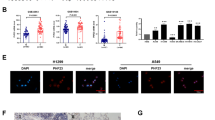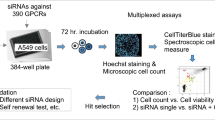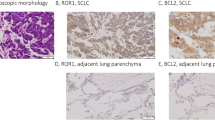Abstract
Irinotecan (CPT-11) is a semisynthetic camptothecin derivative with a broad spectrum of anti-tumour activity. Carboxylesterase (CE) catalyses the conversion of CPT-11 to SN-38 (7-ethyl-10-hydroxycamptothecin), the active form of CPT-11. The antiproliferative effects of CPT-11 and SN-38, CE-activity and topoisomerase I protein expression were investigated in five human small-cell lung cancer (SCLC) cell lines and four human non-small-cell lung cancer (NSCLC) cell lines. Antiproliferative activity, expressed as IC50 values, was determined using the MTT assay. CPT-11 was significantly more active in SCLC than in NSCLC cell lines (P = 0.0036), whereas no significant difference between histological types was observed with SN-38. A significant correlation (r2 = 0.52, P = 0.028) was observed between CE activity and chemosensitivity to CPT-11 but not to SN-38, and significantly higher CE activity was observed in SCLC compared with NSCLC cell lines (P = 0.025). Western blotting experiments showed topoisomerase I protein expressions within a factor of 2, and a granular nuclear staining was detectable in all cell lines by immunocytochemistry of cytospins. No correlation was observed between protein expression and sensitivity to CPT-11 or SN-38. Cellular and medium concentrations of CPT-11 and SN-38 were measured by high-performance liquid chromatography (HPLC) in one SCLC cell line with high CE activity and high sensitivity to CPT-11, and one NSCLC cell line with low sensitivity to CPT-11 and CE activity. Intracellular concentrations of CPT-11 and SN-38 were higher in the SCLC cell line, and this was associated with an increase in cellular uptake of CPT-11 compared with the medium, and an increased intracellular formation of SN-38. In conclusion, CE activity appears to be associated with higher sensitivity to CPT-11 in human lung cancer cell lines and may partly explain the difference in the in vitro sensitivity to CPT-11 between SCLC and NSCLC cells. The assessment of CE activity in clinical material of lung cancer patients undergoing treatment with CPT-11 may be warranted. However, other mechanisms may influence sensitivity to CPT-11, possibly including drug transport.
This is a preview of subscription content, access via your institution
Access options
Subscribe to this journal
Receive 24 print issues and online access
$259.00 per year
only $10.79 per issue
Buy this article
- Purchase on Springer Link
- Instant access to full article PDF
Prices may be subject to local taxes which are calculated during checkout
Similar content being viewed by others
Author information
Authors and Affiliations
Rights and permissions
About this article
Cite this article
van Ark-Otte, J., Kedde, M., van der Vijgh, W. et al. Determinants of CPT-11 and SN-38 activities in human lung cancer cells. Br J Cancer 77, 2171–2176 (1998). https://doi.org/10.1038/bjc.1998.362
Issue Date:
DOI: https://doi.org/10.1038/bjc.1998.362
This article is cited by
-
Irinotecan-Induced Toxicity: A Pharmacogenetic Study Beyond UGT1A1
Clinical Pharmacokinetics (2023)
-
Heterogenous chemosensitivity of a panel of organoid lines derived from small cell neuroendocrine carcinoma of the uterine cervix
Human Cell (2021)
-
Individualization of Irinotecan Treatment: A Review of Pharmacokinetics, Pharmacodynamics, and Pharmacogenetics
Clinical Pharmacokinetics (2018)
-
Resistance Mechanisms to Colorectal Cancer Therapeutics and the Clinical Implications
Current Colorectal Cancer Reports (2017)
-
A self-contained enzyme activating prodrug cytotherapy for preclinical melanoma
Molecular Biology Reports (2012)



